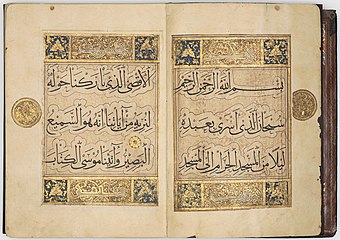Muhaqqaq is one of the main six types of calligraphic script in Arabic.[1] The Arabic word muḥaqqaq (محقَّق) means "consummate" or "clear", and originally was used to denote any accomplished piece of calligraphy.[2]
Often used to copy maṣāḥif (singular muṣḥaf, i.e. loose sheets of Quran texts), this intricate type of script was considered one of the most beautiful, as well as one of the most difficult to execute well.[3] The script saw its greatest use in the Mameluk era (1250–1516/1517).[4] In the Ottoman Empire, it was gradually displaced by Thuluth and Naskh; from the 18th century onward, its use was largely restricted to the Basmala in Hilyas.[5]
History
[edit]The earliest reference to muḥaqqaq writing is found in the Kitab al-Fihrist by Ibn al-Nadim, and the term was probably in use since the beginning of the Abbasid era to denote a specific writing style.[6] Master calligraphers like Ibn Muqla and Ibn al-Bawwab contributed to the development of this and other scripts, and defined its rules and standards within Islamic calligraphy.[7]
Gallery
[edit]-
Double-page from the Qur'an in muhaqqaq dedicated to Abu’l-Qasim Harun ibn ‘Ali ibn Zafar, the vizier of Özbeg (r 1210–1225), the last atabak of Azerbaijan. Khalili Collection of Islamic Art
-
Double-page from the Qur'an in muhaqqaq copied by Yaqut al-Musta'simi. Baghdad, 1282/1283. Khalili Collection of Islamic Art
-
Double-page from the Qur'an in muhaqqaq copied by Ahmad al-Suhrawardi. Baghdad, 1307/1308. Turkish and Islamic Arts Museum
-
Opening pages from the Qur'an in muhaqqaq copied by Ali ibn Muhammad al-Mukattib al-Ashrafi. Cairo, 1372. Egyptian National Library
-
Page from the Qur'an in muhaqqaq copied for Timur by Umar Aqta. Samarkand, c. 1400. Museum of Islamic Art, Doha
-
Album Leaf from a Muraqqa by Hâfiz Osman with basmala in muhaqqaq (upper panel). Istanbul, 1693/1694. Museum of Islamic Art, Berlin
See also
[edit]Notes
[edit]References
[edit]- Nassar Mansour (author), Mark Allen (ed.): Sacred Script: Muhaqqaq in Islamic Calligraphy, I.B.Tauris & Co Ltd, New York 2011, ISBN 978-1-84885-439-0







Well, that’s interesting to know that Psilotum nudum are known as whisk ferns. Psilotum nudum is the commoner species of the two. While the P. flaccidum is a rare species and is found in the tropical islands. Both the species are usually epiphytic in habit and grow upon tree ferns. These species may also be terrestrial and grow in humus or in the crevices of the rocks.
View the detailed Guide of Psilotum nudum: Detailed Study Of Psilotum Nudum (Whisk Fern), Classification, Anatomy, Reproduction